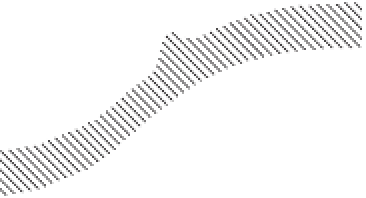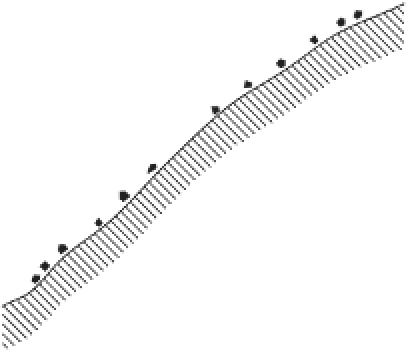Geology Reference
In-Depth Information
hectares of land. The increasing amount of land given
over to roads and buildings, together with the associated
disturbed land, has driven a fairly constant or increasing
reindeer population on to progressively smaller patches of
pasture. In consequence, the patches have suffered exces-
sive grazing and trampling of lichens, bryophytes, and
shrubs. In many areas, sandy soils have been deflated.
The human- and reindeer-induced disturbance may eas-
ily initiate thermokarst formation and aeolian erosion,
which would lead to significant further losses of pasture.
Thermokarst is less likely to develop in the High
Arctic, owing to the lower permafrost temperatures and
the generally lower ice content. Nonetheless, gully ero-
sion can be a serious problem in places lacking a peat
cover. For instance, snow piled up when clear areas for
airstrips and camps are ploughed melts in the spring.
The meltwater runs along minor ruts caused by vehicles.
In a few years, these minor ruts may be eroded into
sizeable gullies. A trickle of water may become a potent
erosive force that transforms the tundra landscape into
a slurry of mud and eroding peat. Restoration work is
difficult because gravel is in short supply and a loss of
soil volume occurs during the summer melt. In any case,
gravel roads, although they will prevent permafrost melt
and subsidence if they are thick enough, have deleteri-
ous side-effects. For instance, culverts designed to take
water under the roads may fill with gravel or with ice
in the winter. In three sites within the Prudhoe Bay Oil
Field, studied from 1968 to 1983, blocked drainage-ways
have led to 9 per cent of the mapped area being flooded
and 1 per cent of the area being thermokarst (Walker
et al
. 1987). Had not the collecting systems, the camps,
and the pipeline corridors been built in an environmen-
tally acceptable manner, the flooding and conversion to
thermokarst might have been far greater. Water running
parallel to the roads and increased flow from the culverts
may lead to combined thermal and hydraulic erosion and
the production of thermokarst.
Global warming
during the twenty-first century is
bound to have a large impact on permafrost land-
scapes, and no effectual countermeasures are available
(Lunardini 1996). Much of the discontinuous permafrost
in Alaska is now extremely warm, usually within 1-2
◦
C
of thawing. Ice at this temperature is highly suscepti-
ble to thermal degradation, and any additional warming
()
a
Free-face and
debris slope profile
()
b
Rectilinear debris-mantled
(Richter) slope
()
c
Smooth convexo-concave
debris-mantled slopes
()
d
Stepped profiles
()
e
Pediment-like forms
Figure 11.6
Types of periglacial slopes. (a) Cliff
above a debris slope. (b) Rectilinear, debris-mantled or
Richter slope. (c) Smooth concavo-convex profile
with frost-shattered and solifluction debris.
(d) Stepped profiles: cryoplanation or altiplanation
terraces. (e) Pediment-like forms, or cryopediments.
Source:
Adapted from French (1996, 171)











